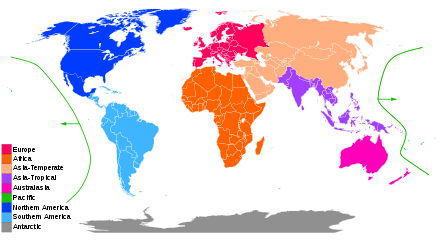World Geographical Scheme for Recording Plant Distributions
The World Geographical Scheme for Recording Plant Distributions (WGSRPD) is a biogeographical system developed by the international Biodiversity Information Standards (TDWG) organization, formerly the International Working Group on Taxonomic Databases.[1] The WGSRPD standards, like other standards for data fields in botanical databases, were developed to promote "the wider and more effective dissemination of information about the world's heritage of biological organisms for the benefit of the world at large". The system provides clear definitions and codes for recording plant distributions at four scales or levels, from "botanical continents" down to parts of large countries. Current users of the system include the International Union for Conservation of Nature (IUCN), the Germplasm Resources Information Network (GRIN), and the World Checklist of Selected Plant Families (WCSP).
The scheme is one of a number developed by Biodiversity Information Standards particularly aimed at taxonomic databases.[2] The starting point was the "need for an agreed system of geographical units at approximately 'country' level and upwards for use in recording plant distributions".[1] The scheme represents a compromise between political and botanical divisions.[3] All boundaries either follow a political boundary (country boundary, province boundary, etc.), or coastlines.[1] The scheme also aims to follow botanical tradition, in terms of the distribution categories used in works like the Flora Europaea, Flora Malesiana, or Med-Checklist.[4] This approach occasionally leads to departures from political boundaries. Thus the scheme follows Flora Europaea[5] in placing the eastern Aegean islands (such as Lesbos, Samos and Rhodes) in the West Asia region,[6] rather than in Europe where they belong politically as part of Greece.
The scheme defines geographic places at four scales or levels, from "botanical continents" down to parts of large countries:[7]
Standardized codes are used to represent the units at each level. Numerical codes are used for Levels 1 and 2, alphabetic codes for Levels 3 and 4.
For more botanically oriented classifications using phytogeography, the scheme's documentation endorses the use of floristic kingdoms, floristic regions, and floristic provinces, as classified by Armen Takhtajan.[9]
The WGSRPD defines nine botanical continents (Level 1), each assigned a single digit code from 1 (Europe) to 9 (Antarctica). Although it is said that "popular concepts of the continents of the world have been maintained, but with one or two slight modifications",[3] some of the botanical continents are notably different from the traditional geographical continents. In particular, Asia is divided into two botanical continents; 5 Australasia consists only of Australia and New Zealand and small outlying islands; most of the islands in the Pacific Ocean are allocated to 6 Pacific; and the division of the Americas into 7 Northern America and 8 Southern America differs from the traditional North America and South America.[3]
